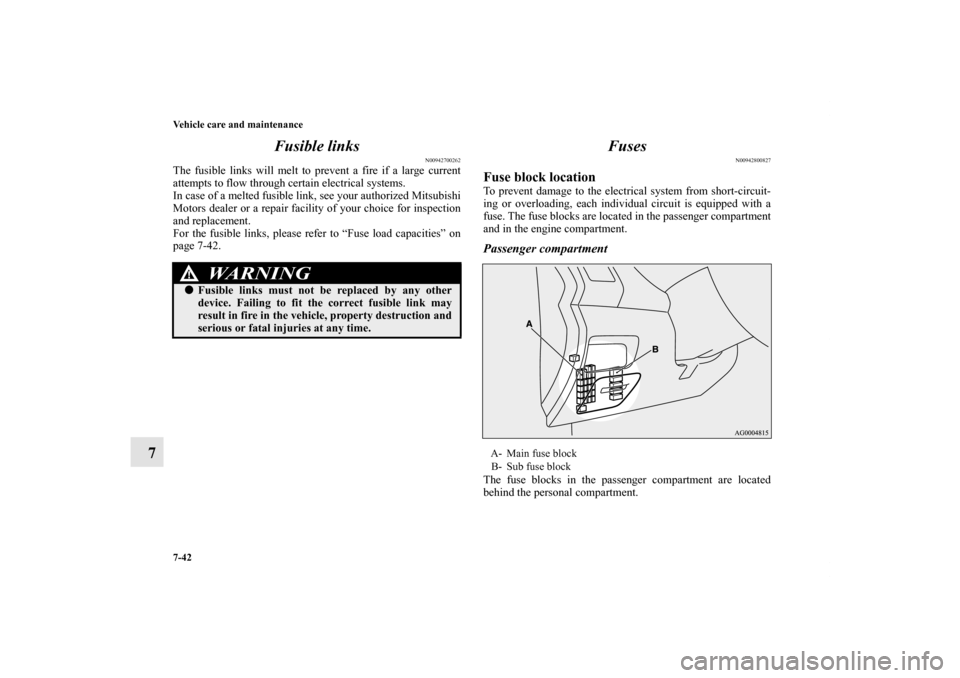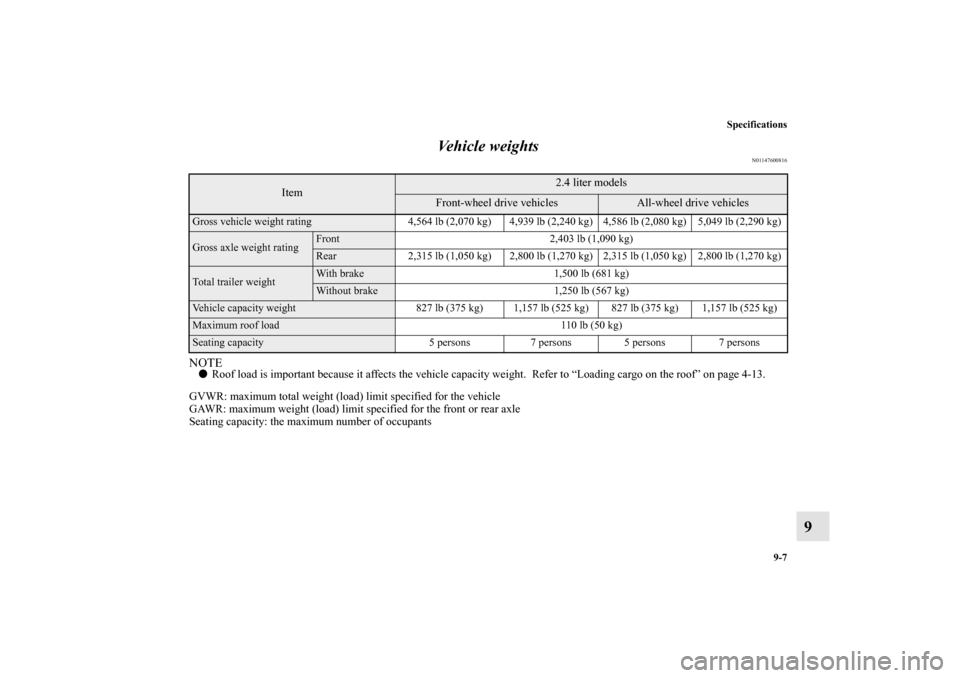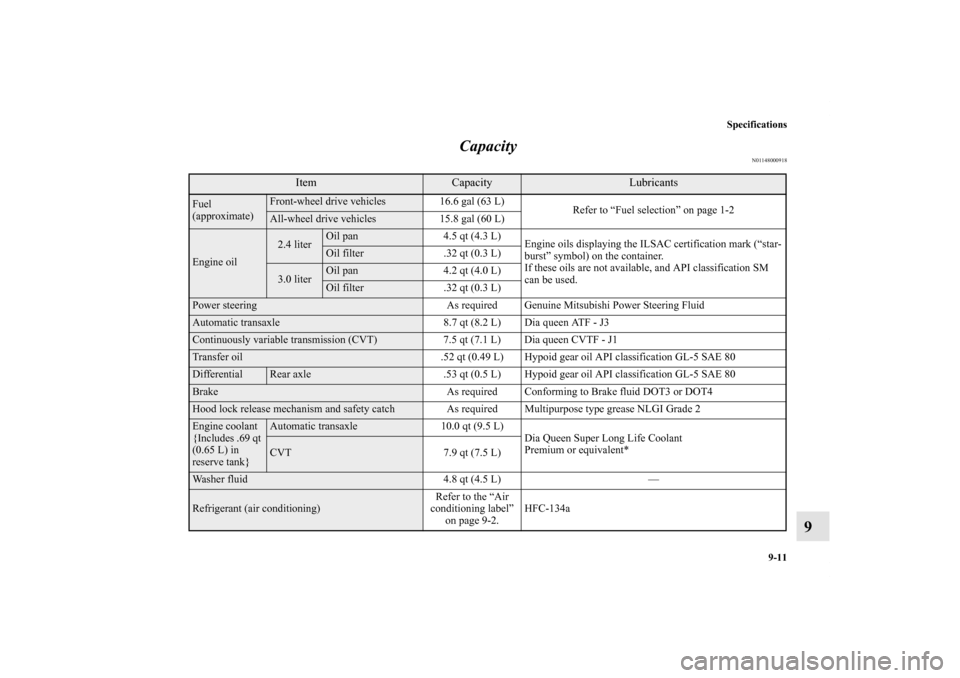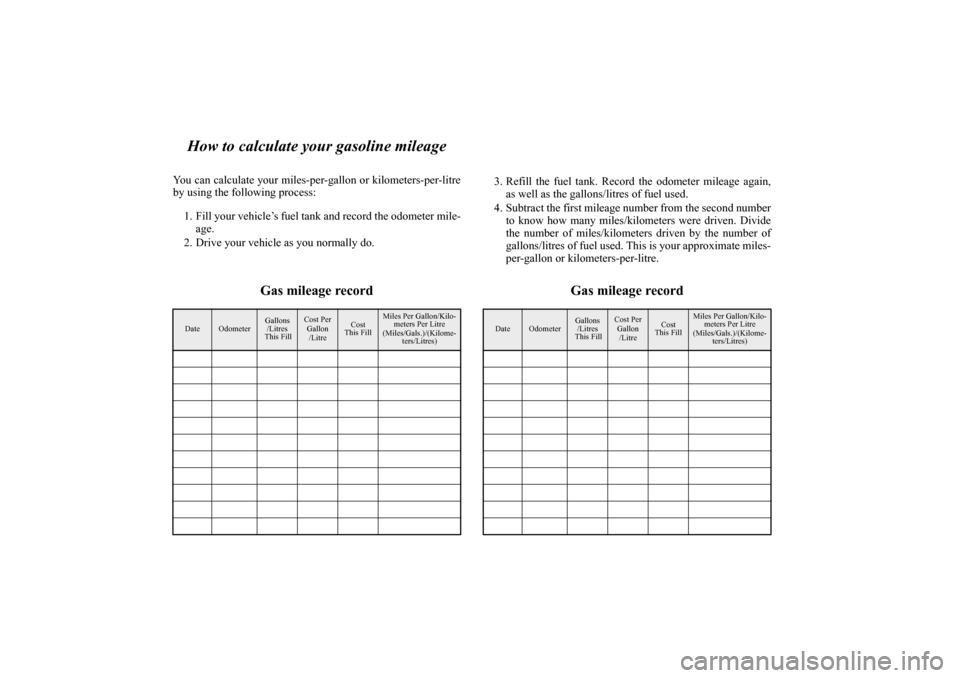Page 633 of 714

7-36 Vehicle care and maintenance
7
Spark plugs
N00940900231
Spark plugs must fire properly to ensure proper engine perfor-
mance and emission-control.
Do not reuse spark plugs by cleaning or regapping. Spark plugs
should be replaced at the mileage specified in the “WAR-
RANTY AND MAINTENANCE MANUAL”.NOTE�Use the recommended or equivalent spark plugs listed
under “Engine specifications” on page 9-9. Use of other
plugs could cause engine damage, loss of performance or
radio noise.Fuel hoses
N00941000040
Check the hose surfaces for any heat and mechanical damage,
hard and brittle rubber, cracking, tears, cuts and abrasions. Pay
special attention to the hoses closest to high heat sources such
as the exhaust manifold. Check all the hose connections, such
as clamps and couplings, to make sure they are secure and that
there are no leaks. If you see any wear or damage, replace the
hoses immediately.Intake valve clearance
N00950100050
Have the valve clearance checked at an authorized Mitsubishi
Motors dealer at the mileage specified in the “WARRANTY
AND MAINTENANCE MANUAL”.
If the engine sounds abnormally loud, have adjustments made
by an authorized Mitsubishi Motors dealer.
Fuel system (tank, pipe line and connection, and
fuel tank filler cap)
N00941300173
Check these regularly for damage or leaks in the fuel lines and
connections. Check the fuel tank filler cap for damage or loose-
ness. Pay special attention to the fuel lines closest to high heat
sources such as the exhaust manifold.
WA R N I N G
!�If you see a fuel leak or if you smell fuel, do not run
the engine. Any spark (including from the ignition),
flame or smoking material could cause an explosion
or fire. Call an authorized Mitsubishi Motors dealer
or a repair facility of your choice for assistance.
BK0122500US.book 36 ページ 2010年5月12日 水曜日 午前11時11分
Page 634 of 714

Vehicle care and maintenance
7-37
7
Evaporative emission control system (except
evaporative emission canister)
N00941400187
If the fuel-vapor vent line is clogged or damaged, the fuel-
vapor mixture will escape, polluting the air.
Have the system checked at an authorized Mitsubishi Motors
dealer at the mileage specified in the “WARRANTY AND
MAINTENANCE MANUAL”.
General maintenance
N00941500247
The next pages list the maintenance service recommended by
Mitsubishi Motors Corporation. In addition to the general
maintenance that needs to be performed at the times listed,
there are other parts which do not usually need regular mainte-
nance.
But, if any of these parts stops working properly, your vehicle
performance could suffer. Have these items checked if you
notice a problem with them.
See your authorized Mitsubishi Motors dealer for assistance, if
you have any questions.Disc brake pads
N00941600059
Good brakes are essential for safe driving. Check the brake
pads for wear. For good braking performance, replace the brake
pads with the same type pads as the originals.Brake hoses
N00941700076
Brake hoses and tubing should be checked for:
�Severe surface cracking, scuffing or worn spots. If the
fabric casing of the hose is showing through any cracks or
worn spots in the rubber hose cover, the hose should be
replaced. The brakes can fail if the hose wears through.
�Improper installation may cause twisting, or wheel, tire or
chassis interference.
BK0122500US.book 37 ページ 2010年5月12日 水曜日 午前11時11分
Page 639 of 714

7-42 Vehicle care and maintenance
7Fusible links
N00942700262
The fusible links will melt to prevent a fire if a large current
attempts to flow through certain electrical systems.
In case of a melted fusible link, see your authorized Mitsubishi
Motors dealer or a repair facility of your choice for inspection
and replacement.
For the fusible links, please refer to “Fuse load capacities” on
page 7-42.
Fuses
N00942800827
Fuse block locationTo prevent damage to the electrical system from short-circuit-
ing or overloading, each individual circuit is equipped with a
fuse. The fuse blocks are located in the passenger compartment
and in the engine compartment.Passenger compartmentThe fuse blocks in the passenger compartment are located
behind the personal compartment.
WA R N I N G
!�Fusible links must not be replaced by any other
device. Failing to fit the correct fusible link may
result in fire in the vehicle, property destruction and
serious or fatal injuries at any time.
A- Main fuse block
B- Sub fuse block
BK0122500US.book 42 ページ 2010年5月12日 水曜日 午前11時11分
Page 641 of 714
7-44 Vehicle care and maintenance
7
Sub fuse block
1. Remove the personal compartment in the same way that
you would with the main fuse block.
2. Use the fuse remover to pry loose the 2 clips (E) on the
bottom cover.
The remover is in the fuse block in the engine compart-
ment.
Refer to “Fuse replacement” on page 7-49.NOTE�When finished, be sure to return the remover to the fuse
block in the engine compartment.
Engine compartmentIn the engine compartment, the fuse block is located as shown
in the illustration.Fuse load capacities
N00954800169
This fuse list shows the names of the electrical systems and
their fuse capacities.
There are spare fuses in the fuse block cover in the engine
compartment. Always replace a blown fuse with one of the
same capacity as the original.1- Push the lock lever.
2- Remove the fuse block cover.
BK0122500US.book 44 ページ 2010年5月12日 水曜日 午前11時11分
Page 698 of 714

Specifications
9-7
9 Vehicle weights
N01147600816
NOTE�Roof load is important because it affects the vehicle capacity weight. Refer to “Loading cargo on the roof” on page 4-13.
GVWR: maximum total weight (load) limit specified for the vehicle
GAWR: maximum weight (load) limit specified for the front or rear axle
Seating capacity: the maximum number of occupants
Item
2.4 liter models
Front-wheel drive vehicles
All-wheel drive vehicles
Gross vehicle weight rating 4,564 lb (2,070 kg) 4,939 lb (2,240 kg) 4,586 lb (2,080 kg) 5,049 lb (2,290 kg)Gross axle weight rating
Front 2,403 lb (1,090 kg)Rear 2,315 lb (1,050 kg) 2,800 lb (1,270 kg) 2,315 lb (1,050 kg) 2,800 lb (1,270 kg)
Total trailer weight
With brake 1,500 lb (681 kg)Without brake 1,250 lb (567 kg)
Vehicle capacity weight 827 lb (375 kg) 1,157 lb (525 kg) 827 lb (375 kg) 1,157 lb (525 kg)Maximum roof load 110 lb (50 kg)Seating capacity 5 persons 7 persons 5 persons 7 persons
BK0122500US.book 7 ページ 2010年5月12日 水曜日 午前11時11分
Page 699 of 714
9-8 Specifications
9
NOTE�Roof load is important because it affects the vehicle capacity weight. Refer to “Loading cargo on the roof” on page 4-13.
GVWR: maximum total weight (load) limit specified for the vehicle
GAWR: maximum weight (load) limit specified for the front or rear axle
Seating capacity: the maximum number of occupants
Item
3.0 liter models
Front-wheel drive vehicles
All-wheel drive vehicles
Gross vehicle weight rating 4,696 lb (2,130 kg) 5,071 lb (2,300 kg) 4,696 lb (2,130 kg) 5,181 lb (2,350 kg)Gross axle weight rating
Front 2,403 lb (1,090 kg)Rear 2,315 lb (1,050 kg) 2,800 lb (1,270 kg) 2,315 lb (1,050 kg) 2,800 lb (1,270 kg)
Total trailer weight
With brake 2,000 lb (907 kg) 3,500 lb (1,588 kg)Without brake 1,400 lb (635 kg)
Vehicle capacity weight 935 lb (424 kg) 1,157 lb (525 kg) 935 lb (424 kg) 1,157 lb (525 kg)Maximum roof load 110 lb (50 kg)Seating capacity 5 persons 7 persons 5 persons 7 personsBK0122500US.book 8 ページ 2010年5月12日 水曜日 午前11時11分
Page 702 of 714

Specifications
9-11
9 Capacity
N01148000918
Item
Capacity
Lubricants
Fuel
(approximate)
Front-wheel drive vehicles 16.6 gal (63 L)
Refer to “Fuel selection” on page 1-2All-wheel drive vehicles 15.8 gal (60 L)
Engine oil
2.4 liter
Oil pan 4.5 qt (4.3 L)
Engine oils displaying the ILSAC certification mark (“star-
burst” symbol) on the container.
If these oils are not available, and API classification SM
can be used.Oil filter .32 qt (0.3 L)
3.0 liter
Oil pan 4.2 qt (4.0 L)Oil filter .32 qt (0.3 L)
Power steering As required Genuine Mitsubishi Power Steering FluidAutomatic transaxle 8.7 qt (8.2 L) Dia queen ATF - J3Continuously variable transmission (CVT) 7.5 qt (7.1 L) Dia queen CVTF - J1Transfer oil .52 qt (0.49 L) Hypoid gear oil API classification GL-5 SAE 80Differential
Rear axle .53 qt (0.5 L) Hypoid gear oil API classification GL-5 SAE 80
Brake As required Conforming to Brake fluid DOT3 or DOT4Hood lock release mechanism and safety catch As required Multipurpose type grease NLGI Grade 2Engine coolant
{Includes .69 qt
(0.65 L) in
reserve tank}
Automatic transaxle 10.0 qt (9.5 L)
Dia Queen Super Long Life Coolant
Premium or equivalent*CVT 7.9 qt (7.5 L)
Washer fluid 4.8 qt (4.5 L) —Refrigerant (air conditioning)Refer to the “Air
conditioning label”
on page 9-2.HFC-134a
BK0122500US.book 11 ページ 2010年5月12日 水曜日 午前11時11分
Page 713 of 714

How to calculate your gasoline mileage
You can calculate your miles-per-gallon or kilometers-per-litre
by using the following process:
1. Fill your vehicle’s fuel tank and record the odometer mile-
age.
2. Drive your vehicle as you normally do.3. Refill the fuel tank. Record the odometer mileage again,
as well as the gallons/litres of fuel used.
4. Subtract the first mileage number from the second number
to know how many miles/kilometers were driven. Divide
the number of miles/kilometers driven by the number of
gallons/litres of fuel used. This is your approximate miles-
per-gallon or kilometers-per-litre.
Gas mileage record Gas mileage record
Date
Odometer
Gallons
/Litres
This Fill
Cost Per
Gallon
/Litre
Cost
This Fill
Miles Per Gallon/Kilo-
meters Per Litre
(Miles/Gals.)/(Kilome-
ters/Litres)
Date
Odometer
Gallons
/Litres
This Fill
Cost Per
Gallon
/Litre
Cost
This Fill
Miles Per Gallon/Kilo-
meters Per Litre
(Miles/Gals.)/(Kilome-
ters/Litres)
MMNA_last page.fm 1 ページ 2010年5月12日 水曜日 午後4時58分